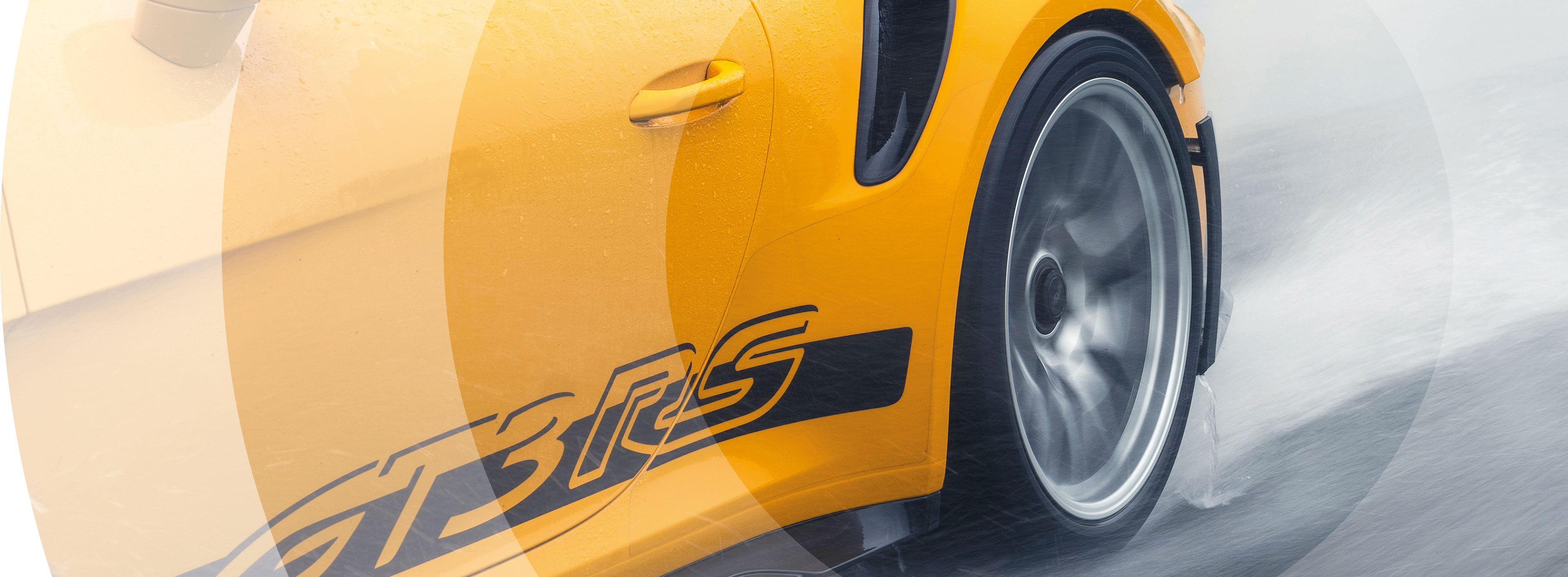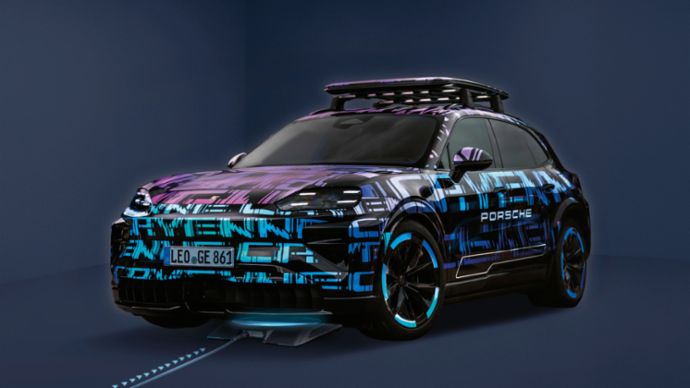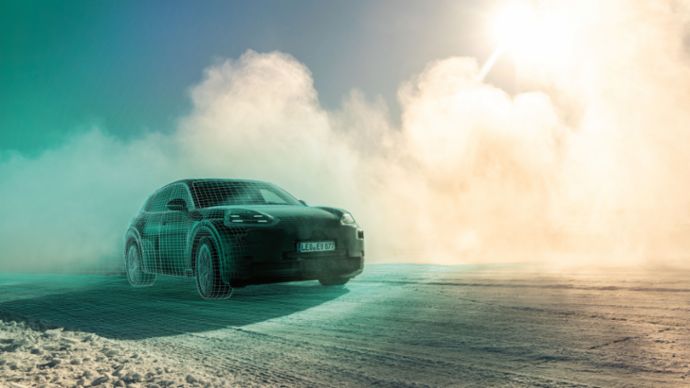A Success All Around
Porsche and Michelin joined forces to develop the MICHELIN Pilot Sport S 5 for the 911 GT3 RS, a street-legal tire that’s suitable for wet conditions and cooler temperatures at the bookends of the track day season. In addition to the digital creation process, a special analog tool played a key role.
May 3, 2024, is a remarkable day in Barcelona for two reasons, the first of which is the weather. It’s raining, which is rare, at least that late in spring in the Spanish city on the Mediterranean. The second noteworthy event takes place that Friday at Circuit de Barcelona-Catalunya in the northern part of the city, with Jörg Bergmeister at the starting line behind the wheel of a Porsche 911 GT3 RS. The approximately 4.7-kilometer course stretches out ahead of Bergmeister, motorsport legend and Porsche brand ambassador. It’s 3 p.m. and the conditions are ideal: wet asphalt and an overcast sky.
Aside from the weather, what makes this moment so special is the fact that the GT3 RS is fitted with wet-weather tires, a prototype of the new MICHELIN Pilot Sport S 5. The tire was developed specifically for wet roads and cooler days, something that has never existed in the history of the GT3. With the development of the MICHELIN Pilot Sport S 5, Porsche and Michelin have not only introduced a whole new tire, but also fulfilled the customers’ desire to be able to drive the GT3 RS even in the cooler and sometimes wetter weather conditions of the fall and spring, significantly extending the track day season and the GT3 RS’s driving capability. The new tire is designed to increase fun and performance, without compromising comfort and handling. Most importantly, the tire offers high performance even outside of its core driving season – wet roads with ambient temperatures between 5 and 15 degrees Celsius. And that’s the reason for the final test in Barcelona: 20 laps on the Grand Prix course.
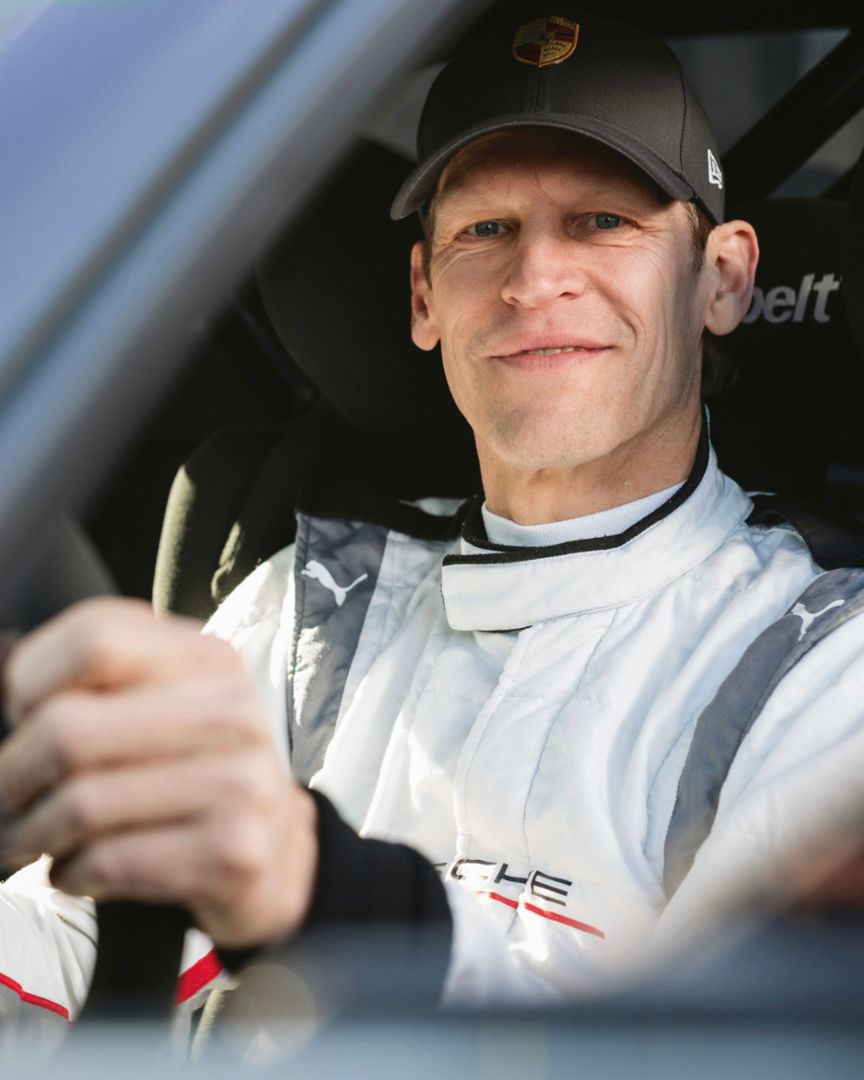
Professional-approved:
Porsche brand ambassador Jörg Bergmeister was a test driver during tire development.The Porsche Weissach and Michelin development centers in Clermont-Ferrand, France, have put many virtual prototypes to the test on digital data highways over the past 18 months. Michelin test drivers have also driven countless laps with a variety of development stages of the tire on the tire manufacturer’s test course in Ladoux in central France. Porsche pilot Jörg Bergmeister himself has made a few appearances there. Bergmeister’s unique sense of car control, which just might be the most important test tool in Porsche tire development, is in demand again here in Barcelona. “Tire development is a very special discipline in car manufacturing,” he explains after his drive. “Despite digital prototypes and virtual development environments, what ultimately counts are the impressions of professional test drivers. The actual driving experience that a tire delivers. How easy it is to regain control of the vehicle at the limits – you can’t simulate that in the lab. Guys like me are responsible for that,” says Bergmeister and laughs.
Developing a new tire is a technological challenge. As the interface between the vehicle and the road, the tire is a strategic component in car manufacturing. It allows the engine and chassis to deliver their performance on asphalt. Tires are responsible for the driving dynamics typical of every Porsche. The tread pattern, rubber blend, and architecture need to be precisely tailored to the vehicle’s performance characteristics. For example, the rubber blend and tread determine the level of grip – and thus the vehicle’s performance and safety. The formula of the ideal rubber blend for certain performance characteristics is just as important as the recipe for a sauce at a three-star restaurant. The rubber blend, too, needs to harmonize perfectly with all of the other components that make up the whole – the chassis and the complete vehicle.
“Vehicle and tires perform in perfect harmony.”
Jörg Bergmeister
The fact is, if tire development focuses on a specific performance characteristic, it usually comes at the expense of another. For example, winter tires require a soft, flexible rubber blend to provide grip and safety at cold temperatures and in poor road conditions. However, softer tires tend to wear at a faster pace. But development has made significant progress over the years. Today’s tires offer a wide range of performance characteristics that once would have seemed impossible. Take, for instance, good wet-weather behavior and minimal rolling resistance, or extraordinary dry-weather performance with high mileage.
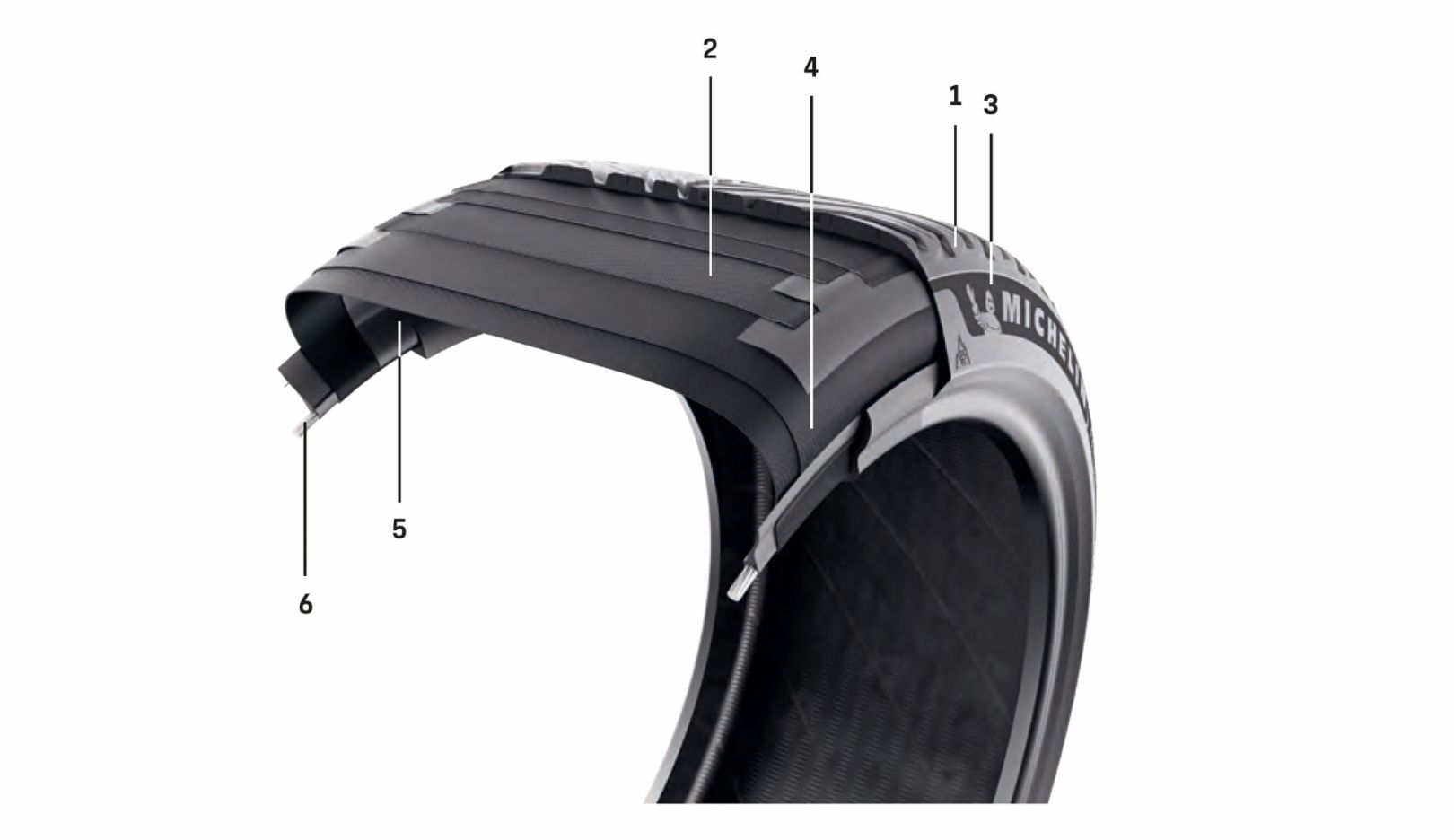
Tire Makeup:
Despite the fact that they’re always black and round, tires are a complex vehicle component. A strategic, high-tech product in the overall work of art that is the chassis. They consist of more than 200 individual components and materials. For example, the rubber blend of the tread (1), which forms the connection to the road, is key to its performance portfolio. Wet-weather tires have a softer rubber blend than traditional summer tires for an extra level of grip. The steel belt of rubberized cords (2) provides the tire with stability, while the rubber sidewall (3) acts as a protective shell around the carcass (4), which is the load-bearing framework inside every tire. The inner liner (5), an airtight layer of synthetic rubber, serves as a seal. The bead core at the center (6) ensures that the tire sits securely on the wheel rim. The tread pattern, in particular, plays a key role, as it determines, for example, wet-weather behavior and grip and thus ensures stability and steering precision.Developing the perfect tire in harmony with the vehicle’s performance data is one of the most demanding tasks in car manufacturing, even for conventional car models. But launching a brand-new tire for a Porsche vehicle, especially a high-performance, extraordinarily precise, and meticulously tuned sports car like the 911 GT3 RS – that’s the ultimate challenge.
Porsche has therefore developed its own quality seal for its tires, the “N” specification, which is only granted once a new tire fulfills all the legal requirements as well as Porsche’s expectations in terms of grip, rolling resistance, wet- and dry-weather behavior, rolling noise, braking distances, and – very importantly – the targeted Nordschleife lap times. “A tire needs to fit the vehicle like a glove,” says Jan Frank, specialist in the driving dynamics/performance of GT street vehicles at Porsche. “Every aspect needs to be precise and perfect. Only then can the chassis, engine, and ultimately the entire vehicle deliver their full performance.” Different dimensions and targeted coordination of front- and rear-axle tires allow Porsche’s typical driving behavior to shine through. Take, for example, the GT3 RS. The rear axle is optimized for traction and driving stability, while the front needs to ensure direct responsiveness.
“The development was an incredible adventure,” says Bertrand Fraenkel, Head of Supersport Tire Development at Michelin. “The extensive expertise of our engineers together with innovative technologies enabled us to explore this completely new tire segment. We used AI and our comprehensive database to determine the best combination of technologies for the carcass, tread compound, and tread pattern.”

Zippy:
With the newly developed MICHELIN Pilot Sport S 5 wet-weather tire, a 911 GT3 RS can deliver its potential to the road even on rainy days.Michelin decided early on to manufacture the tire using the proven C3M process for high-performance tires. This is a production method in which the tire is preprogrammed on a computer and later produced in a process similar to 3D printing. This allowed the engineers to build on the same carcass as the Pilot Sport Cup 2 in order to achieve the stiffness required for the GT3 RS. For example, a wave-shaped tread was chosen to increase the stiffness and balance it between the front and rear tires.
Another fundamental development objective was to optimize hydroplaning behavior. The central section of the tread features four large grooves with a depth of 0.74 centimeters in order to channel more water away, aiming to maintain road contact even in these conditions. In terms of aesthetics, Michelin’s Premium Touch technology was used in a special GT3 RS design. This gives the tire a unique velvet look on the sidewall and a completely matte rubber surface.
However, the most important technology is the tread compound with silica. “Silica is known for giving tires low rolling resistance,” explains Bertrand Fraenkel. “For the GT3 RS tire, we have developed a special silica compound that also improves wet and dry grip.” At the end of development, the benefits were clearly reflected in the lap times themselves. Compared to the ultra-high-performance Pilot Sport Cup 2 NO tire, the test drivers were more than ten seconds faster on Michelin’s wet test track. “That’s a world of difference,” says Mathieu Greco, tire developer at Michelin. This tire was designed for race cars, but not for professional race car drivers. That played a key role in its development. The street-legal tire should enable comfortable vehicle handling. In addition to excelling on wet surfaces, it should also offer a high level of performance when the sun shines on track day in March or October.
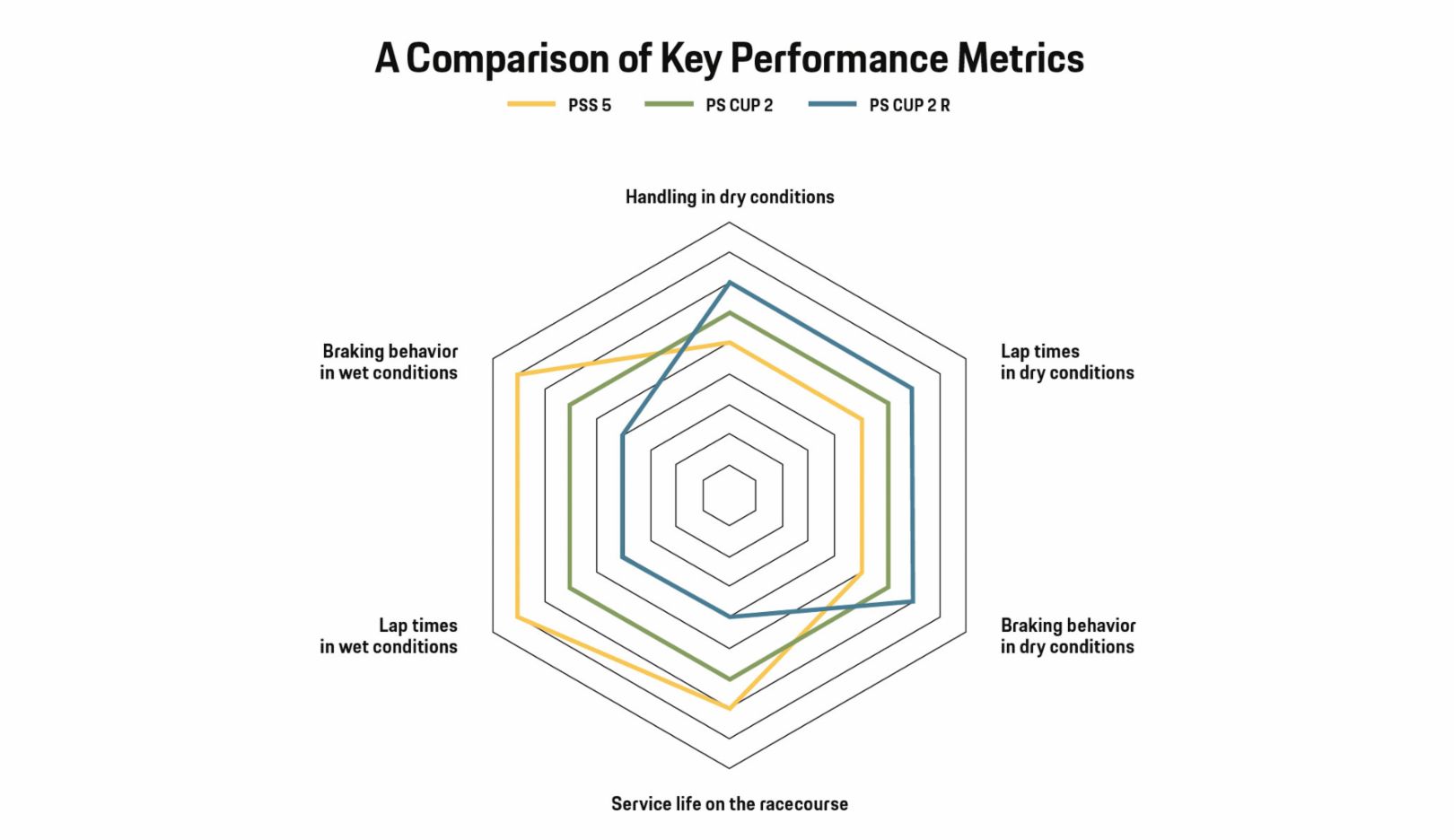
Barcelona is the ideal test location for that. Parked at the starting line in the GT3 RS on that May 3, Jörg Bergmeister is ready for the first sprint. He accelerates to almost 250 kmh. The prototypes of the brand-new tire model, the MICHELIN Pilot Sport S 5, grip the wet asphalt. At the end of the 1.0-kilometer start/finish straights, Bergmeister wrenches the steering wheel to the right and lets the rear of the car drift to the left in a controlled manner. In the blink of an eye, the GT3 is lined up perfectly for the turn, and Bergmeister accelerates. “Crazy,” he’ll report later. He’s never been able to drive a GT3 RS like that on a wet surface before. When road conditions are like that, GT3 vehicles are usually left in the garage. Or they wait in the pit lane for better conditions on track day.
Jörg Bergmeister pushes the tires and vehicle to their very limits, which thanks to the new configuration have been extended. With a track layout designed for Formula 1 requirements and especially difficult transitions between high-speed stretches and challenging curves, Circuit de Barcelona-Catalunya is considered to be one of the most demanding courses. Bergmeister tests the behavior of the tire to see how “snappy” it is – in other words, how brutal and abrupt the transition is between grip and no grip. “Unbelievable,” he says afterwards. Despite the wet conditions and its “very sporty” driving style, the tire is “almost unnaturally un-snappy.” The MICHELIN Pilot Sport S 5 maintains composure even as Bergmeister pushes it to the limits – and that’s saying something. “All of the GT3 power” is on full display. That is, until the tenth lap, when things get a “little tricky,” the racing professional explains. Around 20 minutes into the wet-weather tire test, the sun breaks through and increases the temperature from an initial 10 degrees to nearly 21 degrees Celsius. The surface of the road quickly dries like a towel on a warm beach in nearby Costa Brava.
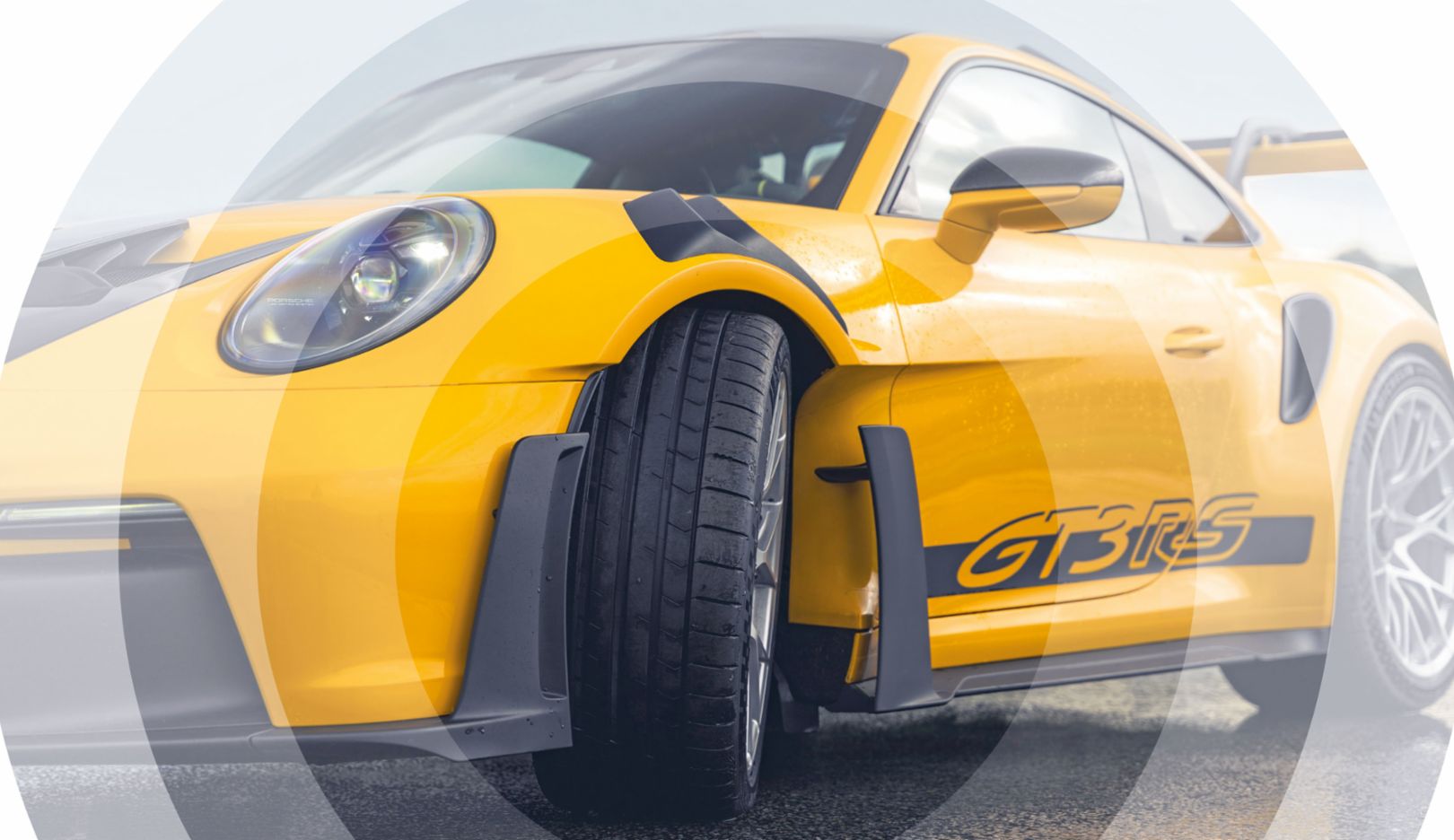
Now the wet-weather tire is put to the test, and Bergmeister pushes it hard. By the end of the test, the conditions are almost summery. Even now, “the vehicle and tires are performing in perfect harmony.” And, after sporty Bergmeister laps – some of them wet, some on sunny, warm asphalt – the tire doesn’t exhibit “any noticeable wear.” The professional is thrilled. Barcelona is usually “a tire-killing course,” as some tires will simply disintegrate “into bliss” after a “wild ride,” he says.
After 20 laps, Bergmeister climbs out of the 911 GT3 RS and shakes his head in disbelief. A smile spreads across his face, more radiant than the sun now shining bright in the blue sky, revealing his satisfaction even before the first comment. The MICHELIN Pilot Sport S 5 receives the coveted “N” specification. It has been tested by Porsche. And, of course, Bergmeister-approved.
Extraordinary Level of Performance
Why did Porsche and Michelin develop the MICHELIN Pilot Sport S 5 for the 911 GT3 RS?
The MICHELIN Pilot Sport S 5 represents a whole new tire segment. Until now, there has never been a wet-weather tire for the GT3. With the new tire, we’re significantly extending the track day season and the 911 GT3 RS’s general driving season. With the Pilot Sport S 5, which is the equivalent of our ultra-high-performance Pilot Sport Cup 2 R tire, we’re fulfilling a customer request: the ability to have fun with the GT3 RS even on wet days.
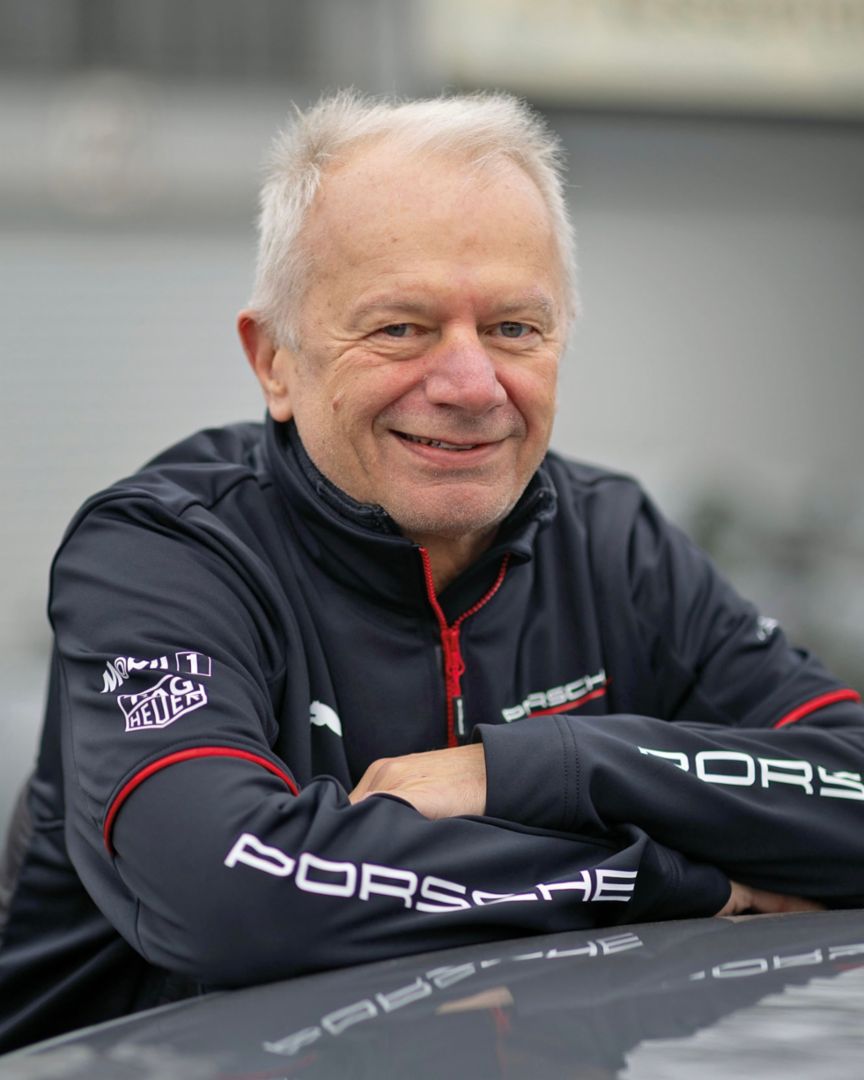
User-friendly:
Jan Frank, specialist in the driving dynamics/performance of GT street vehicles, views the new tire as the fulfillment of a “long-held customer request.”What are the benefits of the tire?
The tire offers extraordinary grip and water displacement properties. Developed specifically for wet conditions, the tread with a depth of up to 0.74 centimeters instantly channels a whole lot of water away, thus greatly reducing the risk of aquaplaning and shifting the critical lift-off speed to higher spheres. The rubber blend with a high percentage of silica is much softer than that of the ultra-high-performance Pilot Sport Cup 2 R tire, increasing grip on wet surfaces. All the same, the tire is very durable with low wear rates. Even in mixed weather with dry stretches, it still performs remarkably well, which also makes it suitable for use as an everyday tire.
What role do test driver experiences play during the development process?
A decisive one! Every stage of tire development was thoroughly evaluated by test drivers over many lap hours. Michelin has test drivers who are trained specifically for Porsche products and can evaluate every nuance in any potential conditions. And then there are our own test drivers like Jörg Bergmeister. Of course, key development steps are also tested in virtual environments with digital prototypes, which saves time and money and is extremely reliable. But human experiences are very important for a strategic key component like the tire, which forms the link between the vehicle and road. Especially when it comes to the tires of a performance-oriented model like the 911 GT3 RS.
Consumption data
911 Carrera GTS
911 GT3 RS
-
13.2 l/100 km
-
299 g/km
-
G Class
-
G Class
